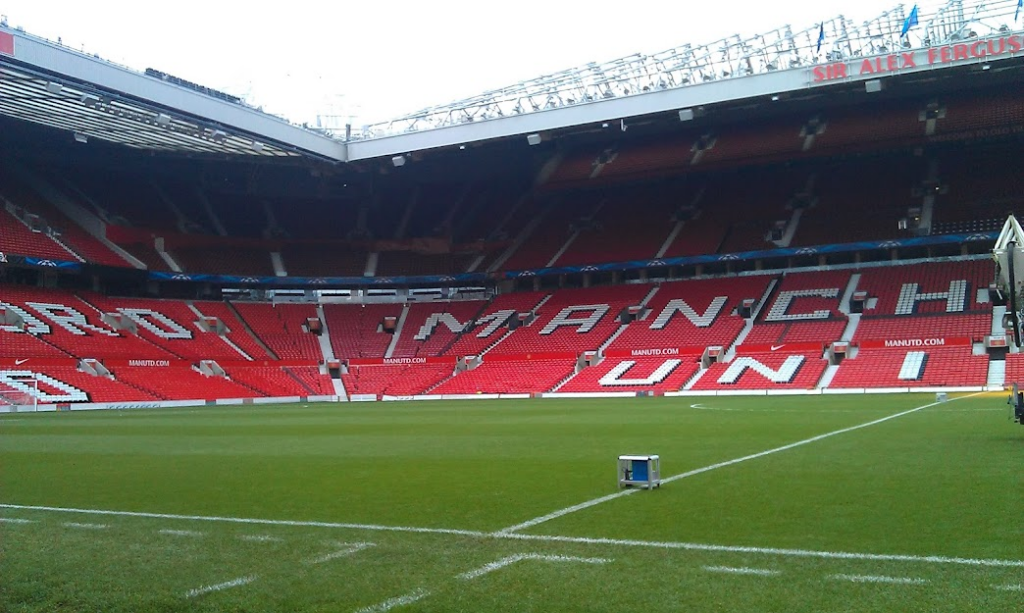With the 2023 relegation of Premier League mainstays Leicster (32,500), Leeds (37,890) & Southampton (32,689) England’s top division lost some pretty large stadiums. The Promotion of Burnley (21,944), Sheffield United (32,050) & Luton (10,356) meant the English Premier League saw a net drop in stadium capacity of over 38,000 seats.
What is the largest stadium capacity in the Premier League? In total for the 2023-24 Premier League season all 20 Premier League teams can host a total of 783,752 fans. This averages out at 39,188 per stadium. Manchester United’s Old Trafford boasts the biggest capacity with 74,310 seats, while newly promoted Luton Town’s Kenilworth Road has the lowest with just 10,356.
It’s time to conquer “The theatre of dreams” pic.twitter.com/xXyZurq0Er
— FC Barcelona (@FCBarcelona) February 23, 2023
From the mighty Manchesters to the Lowly Lutons we look at Premier League Stadium Capacities for the 2023-24 season and what affect the incoming implementation of “Safe Standing” might have.
A list of all 2023-24 Premier League Stadium Capacities
| 2023-24 English Premier League (EPL) Stadium Capacities | |||
| Team | Stadium | Location | Capacity |
| Manchester United | Old Trafford | Manchester (Old Trafford) | 74,310 |
| Tottenham Hotspur | Tottenham Hotspur Stadium | London (Tottenham) | 62,850 |
| West Ham United | London Stadium | London (Stratford) | 62,500 |
| Arsenal | Emirates Stadium | London (Holloway) | 60,704 |
| Manchester City | Etihad Stadium | Manchester (Bradford) | 53,400 |
| Liverpool | Anfield | Liverpool (Anfield) | 53,394 |
| Newcastle United | St James’ Park | Newcastle upon Tyne | 52,305 |
| Aston Villa | Villa Park | Birmingham | 42,657 |
| Chelsea | Stamford Bridge | London (Fulham) | 40,343 |
| Everton | Goodison Park | Liverpool (Walton) | 39,414 |
| Sheffield United | Bramall Lane | Sheffield | 32,050 |
| Brighton & Hove Albion | Falmer Stadium | Falmer | 31,800 |
| Wolverhampton Wanderers | Molineux Stadium | Wolverhampton | 31,750 |
| Nottingham Forest | City Ground | West Bridgford | 30,332 |
| Fulham | Craven Cottage | London (Fulham) | 29,600 |
| Crystal Palace | Selhurst Park | London (Selhurst) | 25,486 |
| Burnley | Turf Moor | Burnley | 21,944 |
| Brentford | Brentford Community Stadium | London (Brentford) | 17,250 |
| Bournemouth | Dean Court | Bournemouth | 11,307 |
| Luton Town | Kenilworth Road | Luton | 10,356 |
With a gross capacity of 783,752 the English Premier League can host an average of 39,188 fans per stadium in 2023-24. Manchester United have boasted the largest stadium every Premier League season, excluding the brief time while Tottenham’s new stadium was under construction when they played their home games in 2017-18 and all but five in the 2018–19 season at England’s national 90,000 capacity, Wembley Stadium.
The Premier League’s Largest Capacity Stadium
Old Trafford, the home of 20 time English Champions Manchester United, is the largest capacity club stadium in England. Known as The Theatre of Dreams it boasts a 74,310 seated capacity. Despite it coming under criticism recently from the likes of former Man United legends Christiano Ronaldo and Gary Neville for it’s increasingly dilapidated nature and lack of investment from Club owners the Glazers, Old Trafford still stands as one of the jewels of English football.

John Henry Davies rescued failing Manchester football club Newton Heath from bankruptcy in 1902, he renamed them Manchester United and by 1908 they were English Champions. Davies did not see their previous ground as being fit for the Champions of England and so in 1908 he began the process of building them a new stadium.
Davies scouted Manchester for the best site to break ground,deciding on some land adjacent to the Bridgewater Canal, at the north end of the Warwick Road in Old Trafford. Designed by Scottish architect Archibald Leitch, Old Trafford was originally targeted with a capacity of 100,000 on 1 seated and 3 standing terraces
The stadium was originally budgeted for £60,000 however, as costs mounted, an extra £30,000 would have been required to get to the total targeted capacity. Club secretary J. J. Bentley proposed a reduction in capacity to 80,000, and eventually in 1910, Manchester United played their first game at Old Trafford. That same season they claimed their second English Championship.
The Premier League’s Smallest Capacity Stadium
Kenilworth Road is the home of Premier League debutants Luton Town. After a meteoric rise from non-league football following relegation from the Football League in 2009, they have returned to the Premier League.
Luton Town have just won the Championship play-off final.
— Luton Town FC (@LutonTown) May 27, 2023
This is the entrance to our stadium.
Incredible to think this ground will be in the Premier League next season 🤯 pic.twitter.com/QPV3ocSYMN
After their 2009 relegation it took Luton Town until 2014 to gain promotion back to the Football League. Since then the rise has been nothing short of historic. In 2017-18 they were promoted to League 1, then the following year to the Championship. After a heartbreaking Playoff defeat in 2022, Luton returned with vengeance in 2023. Beating Sunderland 3–2 on aggregate in the play-off semi-finals. They went on to beat Coventry City 5–6 on penalties after a tense 1–1 draw in the Final to secure promotion to Premier League for the first time in club history.
Kenilworth Road has been the home of Luton Town since 1905. Its tiny 10,356 capacity will supplant Bournemouth’s Dean Court’s 11,307 as the lowest capacity Premier League ground in history when it hosts its first game of the 2023-24 season.

Premier League New Builds Stadiums
Whilst Luton’s Kenilworth Road will be the Premier League’s newest stadium next year, as it has never hosted a game before. It’s certainly not the newest to be constructed.
The Tottenham Hotspur Stadium opened on 3 April 2019 with a ceremony held before the first Premier League game was played there. Tottenham hosted Crystal Palace, beating them 2-0 with Son scoring the stadium’s opening Premier League goal. Spurs’ new ground has a capacity of 62,850, the second largest behind Manchester United’s Old Trafford.
Brentford FC boast the most recently constructed Premier League Stadium. The Brentford Community Stadium is a multi-use stadium in West London. With a capacity of 17,250 it is suitable for use for both Premier League football and rugby union matches. Opened in 2020, the stadium is at the heart of plans to regenerate the surrounding area, including new homes and commercial opportunities.
The planned opening of Everton’s new Stadium on Bramley-Moore Dock in Vauxhall, Liverpool for the 2024-25 season will make it the newest stadium in the Premier League. Eternal Premier League cock-roaches Everton have invested heavily to construct the 53,000 capacity stadium and move away from historic home Goodison Park.
Narrowly avoiding relegation from the Premier League in the 2022-23 could be the turning point for the club. Relegation and the financial implications that come with it may well have doomed the Liverpool based club to financial ruin with loans extended on the expectation the new stadium will boost club revenue. Something that would not have happened if the club had been toiling in the Championship for promotion back to the Premier League.
When it opens the Stadium will be 7th biggest in the Prem, between Liverpool and Newcastle United.
Premier League and Safe Standing
Prior to 1990 standing on terraces at football grounds in England was commonplace. This activity was prohibited following the Taylor Report, which was published in January 1990. The Taylor Report was commissioned after the Hillsborough disaster in 1989, where 97 Liverpool FC fans tragically lost their lives due to overcrowding, poor Policing and inadequate safety measures at the Hillsborough Stadium in Sheffield. As a result, the report recommended that all top-tier football stadiums in England convert to all-seater stadiums to enhance spectator safety. Since the inception of the English Premier League in 1992 stadiums have been required to have all-seater stadiums, and standing sections have not been allowed.
In recent years the practice of ‘safe-standing’ areas has been introduced in some other leagues, such as the Scottish Premiership, where fans can stand in designated areas with rail seating. Safe-standing areas are sections designed with safety features, such as barriers, to allow fans to stand and support their teams while maintaining safety standards. This could massively enhance the fan experience and increase the capacity of all Premier League grounds if implemented.
Ahead of the 2022-23 season The government confirmed Premier League and Championship clubs will be allowed to introduce safe standing areas at football stadiums from the start of that season. Brentford, QPR and Wolves will be the first clubs to join Cardiff, Chelsea, Manchester City, Manchester United and Tottenham, who all took part in a trial in the second half of the 2021-22 season, in offering licensed safe standing areas for both home and away fans.
